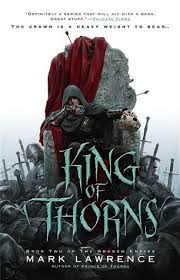
2‑King of Thorns
Chapter 5: Four years earlier
by Mark, Lawrence,The chapter “Four Years Earlier” serves as a flashback, providing critical context for the events unfolding in *King of Thorns*, the second book of *The Broken Empire* series. It revisits a pivotal moment in the protagonist’s past, shedding light on his motivations and the formative experiences that shaped his ruthless persona. The narrative shifts tone to explore the younger, less hardened version of the central character, revealing vulnerabilities and early struggles that contrast with his present-day dominance.
This retrospective segment delves into the protagonist’s earlier life, highlighting key relationships and conflicts that defined his trajectory. The chapter underscores themes of power, survival, and betrayal, as the young ruler navigates a world fraught with danger and treachery. The flashback structure allows readers to draw parallels between past and present, deepening their understanding of his complex character and the moral ambiguities that drive his actions.
The setting of the chapter is richly detailed, immersing readers in the harsh, unforgiving landscape of the Broken Empire. The author employs vivid imagery to depict the protagonist’s surroundings, emphasizing the brutality of his upbringing and the scarcity of trust in his world. This backdrop serves as a crucible for his transformation, illustrating how adversity forged his strategic mind and unyielding resolve.
Ultimately, “Four Years Earlier” acts as a bridge between the protagonist’s past and present, offering insights into his evolution from a vulnerable youth to a formidable king. The chapter enriches the narrative by contextualizing his current struggles and ambitions, while also foreshadowing future challenges. It reinforces the series’ exploration of power dynamics and the cost of leadership, leaving readers eager to see how his past will influence his next moves.
FAQs
1. What is the significance of the chapter title “4: Four years earlier” in King of Thorns: Book Two of the Broken Empire?
Answer:
The chapter title “4: Four years earlier” serves as a temporal marker, indicating a flashback or shift in the narrative timeline. This device is often used to provide context, backstory, or insight into events that shaped the present circumstances of the characters. In King of Thorns, such a shift likely reveals critical background about the protagonist, Jorg Ancrath, or the world of the Broken Empire, helping readers understand his motivations, alliances, or conflicts. The specific mention of “four years” suggests a pivotal moment in Jorg’s past that influences his current actions or mindset.2. How does the structure of this chapter (a brief, standalone section titled with a number and time reference) contribute to the storytelling in King of Thorns?
Answer:
The minimalist structure of this chapter—a single number and time reference—creates intrigue and emphasizes the importance of the temporal shift. By stripping away exposition, the author forces readers to pay attention to the timeline and infer connections between past and present events. This technique aligns with the novel’s gritty, fragmented narrative style, reflecting Jorg’s fractured psyche or the chaotic world of the Broken Empire. It also allows for nonlinear storytelling, a hallmark of the series, which deepens the mystery and complexity of the plot.3. In the context of King of Thorns, why might the author choose to revisit events from four years earlier at this point in the story?
Answer:
Revisiting events from four years earlier likely serves to reveal unresolved conflicts, formative experiences, or hidden truths that directly impact the current narrative. For Jorg Ancrath, a character defined by his brutal past and ruthless ambition, this flashback could expose a turning point—such as a betrayal, loss, or strategic decision—that shapes his present actions. The timing of this revelation may also coincide with a critical juncture in the plot, providing readers with necessary context to understand upcoming twists or character motivations. This technique enriches the story’s depth and emotional resonance.4. How does the sparse presentation of this chapter (lacking detailed content in the provided input) reflect the tone or themes of King of Thorns?
Answer:
The chapter’s sparse presentation mirrors the novel’s overarching themes of ambiguity, violence, and unpredictability. King of Thorns thrives on moral complexity and unreliable narration, and a brief, enigmatic chapter forces readers to engage actively with the text, piecing together clues about the world and characters. This style reinforces the bleak, unforgiving atmosphere of the Broken Empire, where information is scarce and trust is fragile. The lack of detail may also symbolize Jorg’s fragmented memory or the selective nature of his storytelling, inviting readers to question what is being omitted or emphasized.5. If this chapter is part of a larger flashback sequence, how might it influence the reader’s perception of Jorg Ancrath’s character?
Answer:
If this chapter initiates or continues a flashback sequence, it could humanize Jorg or complicate his morally ambiguous persona. By revealing his past struggles, vulnerabilities, or pivotal choices, the author might elicit sympathy or understanding from readers, even as Jorg commits ruthless acts in the present. Alternatively, the flashback could underscore the origins of his cynicism or cruelty, justifying his worldview. The contrast between past and present Jorg invites readers to reflect on themes of trauma, power, and redemption, making him a more multidimensional and compelling protagonist.
Quotes
1. “King of Thorns: Book Two of the Broken Empire”
This title quote sets the tone for the chapter, indicating a continuation of the dark, power-driven narrative from the first book. It hints at themes of rulership, conflict, and moral ambiguity that define the series.
2. “4: Four years earlier”
This temporal marker is significant as it establishes a flashback structure, suggesting the chapter will explore formative events from the protagonist’s past that shaped his current identity as the “King of Thorns.”
